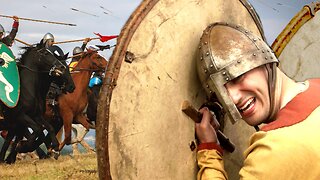Premium Only Content

NASA Admits To Best Fails And NASA Fraud Compilation Unrefuted Proof Of Wires
There's a lot more proof of deception out there, but I wanted to compile the most obvious ones and keep them in one place. I'm discovering that a lot of the original links to such footage are no longer working as they are being deleted. The footage is from space channels, so they aren't just targeting truther channels with the deletion of entire channels. I will post the most up to date links, but some of the originals are gone.
https://en.wikipedia.org/wiki/Moon_landing_conspiracy_theories
One giant ... lie? Why so many people still think the moon landings were faked.
It all started with a man called Bill Kaysing and his pamphlet about ‘America’s $30bn swindle’ ...
Richard Godwin
Richard Godwin
Wed 10 Jul 2019 01.00 EDT
It took 400,000 Nasa employees and contractors to put Neil Armstrong and Buzz Aldrin on the moon in 1969 – but only one man to spread the idea that it was all a hoax. His name was Bill Kaysing.
It began as “a hunch, an intuition”, before turning into “a true conviction” – that the US lacked the technical prowess to make it to the moon (or, at least, to the moon and back). Kaysing had actually contributed to the US space programme, albeit tenuously: between 1956 and 1963, he was an employee of Rocketdyne, a company that helped to design the Saturn V rocket engines. In 1976, he self-published a pamphlet called We Never Went to the Moon: America’s Thirty Billion Dollar Swindle, which sought evidence for his conviction by means of grainy photocopies and ludicrous theories. Yet somehow he established a few perennials that are kept alive to this day in Hollywood movies and Fox News documentaries, Reddit forums and YouTube channels.
Despite the extraordinary volume of evidence (including 382kg of moon rock collected across six missions; corroboration from Russia, Japan and China; and images from the Nasa Lunar Reconnaissance Orbiter showing the tracks made by the astronauts in the moondust), belief in the moon-hoax conspiracy has blossomed since 1969. Among 9/11 truthers, anti-vaxxers, chemtrailers, flat-Earthers, Holocaust deniers and Sandy Hook conspiracists, the idea that the moon landings were faked isn’t even a source of anger any more – it is just a given fact.
The podcast kingpin Joe Rogan is among the doubters. So too is the YouTuber Shane Dawson. A sociology professor in New Jersey was exposed last year for telling his students the landings were fake. While Kaysing relied on photocopied samizdat to alert the world, now conspiracists have the subreddit r/moonhoax to document how Nasa was “so lazy” it used the same moon rover for Apollo 15, 16 and 17; or how “they have been trolling us for years”; or to bring up the fact there is “one thing I can’t get my head around ...”
“The reality is, the internet has made it possible for people to say whatever the hell they like to a broader number of people than ever before,” sighs Roger Launius, a former chief historian of Nasa. “And the truth is, Americans love conspiracy theories. Every time something big happens, somebody has a counter-explanation.”
It turns out British people love conspiracy theories, too. Last year, the daytime TV show This Morning welcomed a guest who argued that no one could have walked on the moon as the moon is made of light. Martin Kenny claimed: “In the past, you saw the moon landings and there was no way to check any of it. Now, in the age of technology, a lot of young people are now investigating for themselves.” A recent YouGov poll found that one in six British people agreed with the statement: “The moon landings were staged.” Four per cent believed the hoax theory was “definitely true”, 12% that it was “probably true”, with a further 9% registering as don’t knows. Moon hoaxism was more prevalent among the young: 21 % of 24- to 35-year-olds agreed that the moon landings were staged, compared with 13% of over-55s.
Kaysing’s original queries are fuelling this. One is the fact that no stars are visible in the pictures; another is the lack of a blast crater under the landing module; a third is to do with the way the shadows fall. People who know what they are talking about have wasted hours explaining such “anomalies” (they are to do with, respectively, camera-exposure times, the way thrust works in a vacuum and the reflective qualities of moondust). Yet until his death in 2005, Kaysing maintained that the whole thing was a fraud, filmed in a TV studio. “It’s well documented that Nasa was often badly managed and had poor quality control,” he told Wired in 1994. “But as of 1969, we could suddenly perform manned flight upon manned flight? With complete success? It’s just against all statistical odds.”
He was right about that at least. When the Soviets launched Sputnik 1 in October 1957 (followed one month later by Sputnik 2, containing Laika the dog), the US space programme was all but non-existent. Nasa was founded in 1958 and managed to launch Alan Shepard into space in May 1961 – but when John F Kennedy announced that the US “should commit itself to achieve the goal, before this decade is out, of landing a man on the moon and returning him safely to the Earth”, it seemed a stretch. By the mid-60s, Nasa was consuming more than 4% of the US federal budget, but while the Soviets were achieving more firsts – the first woman in space (1963), the first extra-vehicular activity, ie spacewalk (1965) – the Americans experienced various setbacks, including a launchpad fire that killed all three Apollo 1 astronauts.
If you have ever been to the Science Museum in London, you will know that the lunar module was basically made of tinfoil. Apollo 8 had orbited the moon in 1968, but, as Armstrong remarked, correcting course and landing on the moon was “far and away the most complex part of the flight”. He rated walking around on the surface one out of 10 for difficulty (despite the problems he had with the TV cable wrapping around his feet), “but I thought the lunar descent was probably a 13”.
That is until you compare it with the difficulty of maintaining a lie to the entire world for five decades without a single slip from any Nasa employee. You would also have to imagine that 2019-era special effects were available to Nasa in 1969 and not one of the 600 million TV viewers noticed anything amiss. Stanley Kubrick’s 2001: A Space Odyssey (1968) is a decent indication of what Hollywood special effects could do at the time – and it’s extremely shonky. It genuinely was simpler to film on location.
If we pass over “World war two bomber found on moon” – a Sunday Sport front page from 1988 – the moon-hoax theory entered the modern era in 2001, when Fox News broadcast a documentary called Did We Land on the Moon? Hosted by the X-Files actor Mitch Pileggi, it repackaged Kaysing’s arguments for a new audience. Launius, who was working at Nasa at the time, recalls much banging of heads against consoles. “For many years, we refused to respond to this stuff. It wasn’t worth giving it a hearing. But when Fox News aired that so-called documentary – stating unequivocally ‘We haven’t landed on the moon’ – it really raised the level. We began to receive all kinds of questions.”
Most of the calls came not from conspiracists, but from parents and teachers. “People were saying: ‘My kid saw this, how do I respond?’ So, with some trepidation, Nasa put up a webpage and sent out some materials to teachers.”
A particular bugbear in the Fox News documentary was a poll claiming that 20% of Americans believed the moon landing was faked. Launius says that polls tend to put the figure at between 4% and 5%, but it’s easy to phrase poll questions to achieve a more eye-catching result. “Every time there’s a hearing in a serious periodical – even an offhand comment in a movie – it just seeds this stuff.” He cites a scene in Christopher Nolan’s Interstellar (2014) in which a schoolteacher informs Matthew McConaughey’s character that the moon landings were hoaxed in order to win the propaganda war against the Soviet Union. “It’s a throwaway in the film. But it really did churn up a big response.”
Oliver Morton, the author of The Moon: A History for the Future, believes the persistence of the moon hoax isn’t surprising. Given an implausible event for which there is lots of evidence (Apollo 11) and a plausible event for which there is zero evidence (the moon hoax), some people will opt for the latter. “The point of Apollo was to show how powerful the American government was in terms of actually doing things,” he says. “The point of moon-hoax theory is to show how powerful the American government was in terms of making people believe things that weren’t true.” But the hoax narrative was only really possible as Apollo never led anywhere – there were no further missions after 1972. “As the American mind turns back to paranoia in the 1970s, it becomes more pleasing to believe in this,” he says.
James Bond has to take a small share of the blame. In Diamonds Are Forever (1971), Sean Connery busts into a Nasa facility by way of a Las Vegas casino. A chase ensues across a film set dressed up to look like the moon, complete with earthbound astronauts. But here it’s more like a visual joke, a way of justifying a moon buggy chase across the Nevada desert. By the time of Peter Hyams’ Kaysingian conspiracy thriller Capricorn One (1978), the idea that the government was fooling everyone was no laughing matter. Here it’s about a Mars mission that goes wrong. The authorities opt to fake it and kill the astronauts (one of whom is played by OJ Simpson) to prevent them revealing the truth. In the post-Watergate era, the idea that the government could lie on this scale had become much more plausible.
Apollo marked a turning point between the optimism of the 60s and the disappointments of the 70s. “We can put a man on the moon so why can’t we do X?” became a common refrain. As Morton says: “Yes, the government can set itself an extraordinary goal and go on to achieve it, but that doesn’t mean it can win the war in Vietnam, or clean up the inner cities, or cure cancer or any of the things that Americans might have actually wanted more. The idea that the government isn’t really powerful, it just pretends it is – you can see how it feeds into the moon hoax.”
Moon-hoax theories tend to be about what didn’t happen rather than what did. Conspiracists are divided on whether the earlier Apollo, Mercury, Gemini and Atlas missions were also fakes, whether Laika or Yuri Gagarin ever made it into space, and what role Kubrick played. But while the first generation of lunar conspiracists were motivated by anger, these days it’s more likely to be boredom. The line between conspiracy and entertainment is far more blurry.
Still, while irritating for those involved – Buzz Aldrin punched moon conspiracist Bart Sibrel in 2002 – in one sense the conspiracy idea is harmless, at least compared with misinformation about vaccinations or mass murders. Morton notes that it is one of the few conspiracy theories that isn’t tainted by antisemitism. Nor does it seem to be one to which Donald Trump, the ultimate product of news-as-entertainment, subscribes. The dynamics of the modern internet have clearly not helped: look up Apollo videos on YouTube and before long moon-hoax documentaries start lining up in the autoplay queue. But there is little evidence that Russian disinformation agents have spread moon conspiracies as they have anti-vaxxing propaganda, for example. Although, if you think about it, it would make perfect sense for them to do so: a neat way of restoring Russian prestige while establishing continuity between the cold war and the information wars.
Then again, the USSR had the means to expose the Americans at the time; it was listening in. “We were there at Soviet military base 32103,” the Russian cosmonaut Alexei Leonov recently recalled. “I swear to God we sat there with our fingers crossed. We hoped the guys would make it. We wanted this to happen. We knew those who were on board and they knew us, too.”
The growing strength of the hoax theory is “one of the things that happens as time recedes and these events are lost”, laments Launius. “We’ve seen it with the second world war and the Holocaust. A lot of the witnesses are passing from the scene and it’s easy for people to deny that it took place. Who is left to counteract things that are untrue? Mythologies develop and become the dominant theme.”
Perhaps the hardest thing to believe in is the idea that humans might have accomplished something transcendent – something that even brought out the best in Nixon. “Because of what you have done, the heavens have become part of man’s world,” he said in his telephone call to Aldrin and Armstrong on the moon. “And as you talk to us from the Sea of Tranquility, it inspires us to redouble our efforts to bring peace and tranquility to Earth.”
We have less faith in ourselves these days. Most moon conspiracists treat the whole thing as a joke, a rabbit hole to go down from time to time. Perhaps if Nasa returns to the moon – possibly as early as 2024, depending on Trump’s whims – it will be replaced in time by Mars conspiracies.
Still, you could see the persistence of the moon conspiracy as a compliment to the Apollo scientists. “In a way, the moon hoaxers are taking the Apollo missions far more seriously than most people do,” says Morton. “It’s a sign that they really care. They think that Apollo really mattered.” The truth is that the moon landings didn’t really change life on Earth. Not yet anyway.
This article was amended on 10 and 11 July 2019. An earlier version said that Nasa launched Alan Shepard into orbit in May 1961. However, that flight was suborbital. In addition, Nasa was consuming more than 4% of the US federal budget in the 1960s, not more than 4% of the country’s GDP as an earlier version said. This has been corrected.
CLAIM: Footage purporting to show astronauts aboard the International Space Station is staged and was actually filmed on Earth.
AP’S ASSESSMENT: False. A spokesperson for NASA and space science experts say the footage is legitimate and that there is ample evidence to show that there are real people on the massive research complex floating above Earth. Additionally, examples cited as proof of an elaborate hoax are easily explained. Footage of astronauts in space suits working underwater is from training exercises at NASA, for example, and video glitches are due to satellite transmission interruptions.
THE FACTS: Some social media users are reviving a long-running conspiracy theory that no one is actually manning the wheel in the International Space Station that’s been orbiting Earth for more than two decades now.
A number are sharing a video clip that purports to show visual evidence that many scenes from the football field-sized floating laboratory are faked using Hollywood tricks.
The clip suggests some footage from the station contains astronauts purportedly pulling at hidden wires or wearing harnesses in order to appear to be in a gravity-less environment.
It also suggests that “air bubbles” can be seen in some of the shots of astronauts floating outside the station, proving that the images were actually shot underwater in a movie studio and not in space.
“If astronauts are really up there, why are they faking the footage?” wrote one user in an Instagram post that’s been liked nearly 11,000 times as of Thursday. “I can think of a lot better things to do with $3 BILLION per year!”
But NASA officials dismissed the notion, saying video glitches cited in the posts as evidence of “green screen” and CGI use are actually the result of brief transmission interruptions between the station’s communication antennas and the agency’s satellite network.
“At no time have props, green screen, wires or simulated underwater facilities substituted for actual real-time operation on the space station,” Sandra Jones, a Houston-based spokesperson, wrote in an email Thursday that also included links to the agency’s blog about the crew’s activities as well as its “Spot the Station” tracking tool.
Space experts concurred, noting that many of the other phenomena cited in the video are also easily explained.
“None of it remotely has merit,” Jonathan McDowell, an astrophysicist with the Center for Astrophysics at Harvard University. “The material you can see on NASA TV and onRoscosmosvideos of live coverage of crewmembers aboard ISS is clearly legit and to suggest it’s faked is just silly and ignorant.”
He argued that the portion of the video clip that purports to show an astronaut tugging at a suspension wire holding up one of his colleagues more likely depicts the space explorer adjusting a microphone or headset cable behind his colleague during an on-camera interview.
McDowell added that amateur radio operators frequently speak with astronauts in orbit, and the radio frequency shifts they experience during those communications is evidence the astronauts are high above the planet.
“There’s a thing called the Doppler shift which changes the frequency of a radio signal from a moving object,” he explained in an email. “From that you can prove that the radio transmitter is moving at very high speeds such that it must be in orbit.”
Joshua Colwell, a planetary scientist who chairs the University of Central Florida’s physics department, said the footage of astronauts in spacesuits working underwater also isn’t proof space scenes are staged.
The video is actually from training exercises at NASA’s Neutral Buoyancy Lab, where astronauts prepare for the weightless environment of space, he said.
And while it’s true that Italian astronaut Luca Parmitano “nearly drowned” when his helmet took on water, as the video notes, that’s not a smoking gun, either, Colwell said.
The 2013 incident _ along with a similar, less severe one last year _ was actually the result of a faulty cooling system in the astronaut’s space suit, which contains water.
“There is no air in the vacuum of space to conduct heat away from the astronaut,” Colwell explained in an email. “So the spacesuits use a water cooling system to keep astronauts from overheating.”
What’s more, the underwater air bubbles purportedly captured in some videos of astronauts doing work outside the space station are more likely dust or ice particles, he said.
“Bubbles of gas moving through a fluid do not follow a perfectly straight line as they rise to the surface,” Colwell explained in an email. “The things I saw in the video shown do not move in parallel lines but move outward like a fan from a common point of origin, and they move at a constant speed and in perfectly straight lines.”
Built through a partnership of five space agencies from 15 countries, the International Space Station launched in 1998 and has been continuously occupied since November 2000, according to NASA.
Among the current crew of seven are astronauts from the United States, Russia and the United Arab Emirates.
On Friday, two of the astronauts are planning a more than6-hour long spacewalk to work on power cables and a communications antenna in preparation for the installation of a new solar array, according to NASA, which maintains a website blog and social media accounts providing frequent updates about the crew’s activities.
The Astronaut Training Pool Introducing NASA’s Curious Universe
Our universe is a wild and wonderful place. Join NASA astronauts, scientists and engineers on a new adventure each week — all you need is your curiosity. Visit the Amazon rainforest, explore faraway galaxies and dive into our astronaut training pool. First-time space explorers welcome.
About the Episode
Before astronauts head to space, they have to dive into the Neutral Buoyancy Lab. Take a swim in NASA's underwater training ground with astronaut Nick Hague.
NICK HAGUE: The Neutral Buoyancy Lab, or “the pool” as I like to call it, it’s a really remarkable place. It’s so massive… 200 feet long, 100 feet wide … and the water is crystal clear. And, if none of the safety divers have started to get in the water yet, the top is as still as it can be. The water is so clear you can just see straight through and see all the models down in the water. And so you get to see the magnitude of what you’re gonna go down and work on here shortly.
[NEUTRAL BUOYANCY LAB SPLASH SOUND]
NICK HAGUE: It’s an amazing experience. When I first came down here, that was when I first put on the spacesuit and was lowered into the water and started floating around in the water …. It felt like this is astronaut training. Hi, I’m Nick Hague. I’m an astronaut at NASA. I, uh, I explore space for a living.
HOST PADI BOYD: This is NASA’s Curious Universe. Our universe is a wild and wonderful place. I’m Padi Boyd, and in this podcast, NASA is your tour guide.
In this episode, we’re exploring the underwater training ground where astronauts train for space.
[PAUSE/SCENE CHANGE TO SPACE]
HOST PADI BOYD: There are humans in space right now. In fact, humans have lived in space continuously for nearly twenty years ...on board the International Space Station.
NICK HAGUE: The International Space Station ... it is gigantic. Imagine this space station floating around with these gigantic solar solar arrays, these wings of solar cells that are collecting the Sun's energy, and that's how we power the station ... It's the size of a football stadium. On the inside, it's got kind of the volume of a large jumbo jet and so that's the area we live and work in. We're up there, you know, it took 100 launches, and it took 100 spacewalks to put this thing together. And we've been up there living inside the station. It's been inhabited continually for two decades now.
The space station orbits around Earth, about 250 miles above ground. The international crew that lives and works on board is doing critical research that can’t be done anywhere else.
NICK HAGUE: We're up there trying to perform this science, because on the space station, gravity isn't the dominant force. You know, if you look around you, everything around you is controlled by gravity. Everything in the room you're sitting in is held down to a table or to a floor because of gravity, and up there, all that goes away, and that's when we can make some really key scientific discoveries.
The ISS is a unique place to study human health and medicine, on top of the more obvious scientific questions about astronomy and meteorology. Weightlessness helps us understand the possibilities for long-term human space exploration. And it helps us understand life here on Earth a little better, too.
NICK HAGUE: Our job, working on the space station, is to go up there and perform science experiments and try to discover new things, whether those are new materials that might help people on the ground or those may be new medical breakthroughs that might help people on the ground. And so we’re up there constantly kind of pushing the boundaries of what we know … helping scientists on the ground make breakthrough discoveries. It’s allowing us to learn more about ourselves, the human body, about the universe around us, and how to improve life on the ground … and how to take those discoveries and push further into the unknown, into space.
HOST PADI BOYD: Before embarking to a place where very few humans have been, astronauts train for two years. In that short time they are required to learn a lot more than you might expect ...
NICK HAGUE: Astronaut training, in a nutshell, is you need to be a jack of all trades. You need to be able to do a little bit of everything.
HOST PADI BOYD: Repairing and servicing the International Space Station, learning Russian, and receiving medical training — astronauts must be prepared for every possible scenario. But before an astronaut ever sets foot aboard the space station, they have to train somewhere you might not expect ...
[Deep plunge/cannonball splash sound]
HOST PADI BOYD: This isn’t just any old swimming pool … it’s the Neutral Buoyancy Lab located at NASA’s Johnson Space Center in Houston, Texas. This special pool contains 6.2 million gallons of water … enough to fit nine Olympic-sized pools inside. It’s where astronauts like Nick come to train.
NICK HAGUE: So the pool is this gigantic pool. It's 200 feet long. It's 100 feet wide, and it's 40 feet deep. It is enormous. It's still not big enough to fit the entire space station in it, but it fits full-scale large chunks of the station so that we can practice. And that's, that's our training ground.
HOST PADI BOYD: The pool is where astronauts first get acquainted with the armor that protects them from space … their spacesuit! And that can be its own challenge. First thing? You’ve got to suit up. It can take about 45 minutes and the assistance of multiple suit technicians to get the suit on — checking to make sure that every piece is fitted and working properly, from the helmet locking into place to the gloves fitting around every finger.
NICK HAGUE: You have to learn how to use the spacesuit. Because, it's not like wearing clothes... It’s, it's constraining, and it limits some of the things you can do. It's fatiguing because of the pressure of having it stiff, and so you have to learn how to use it, and that takes hours underwater, getting to know your spacesuit.
HOST PADI BOYD: Once you have the suit on and it’s been double and triple checked, you can prepare to enter the Neutral Buoyancy Lab. Even though you’re not out in space just yet, the pool will simulate what you might feel once you’re out there. Why? Because being underwater simulates weightlessness.
NICK HAGUE: The Neutral Buoyancy Lab is there to train us, because that's one of the places or one of the ways that we can try to simulate being weightless.. So that idea of nuetral buoyancy.
HOST PADI BOYD: It’s called “neutral buoyancy” because when you’re in water and you don’t sink but also you don’t float, you’re completely neutral. It’s like you’re “hovering” in place.
NICK HAGUE: And so it feels as though I’m weightless and I can maneuver myself around the outside of the space station and have the experience of working in a weightless environment. And so we’re constantly trying to balance out the weight of an object with its buoyancy so that things just float in front of you.
HOST PADI BOYD: Weights and flotation devices are carefully combined to let astronauts feel what it’s like to be weightless in space. When an astronaut is training in the pool, their backpack — the Primary Life Support Subsystem — is filled with air they can breathe and instruments that monitor their health.
NICK HAGUE: You've got to get everything straight because once you go underwater, that's all you've got are the tools you took with you. You're going to be down there for six hours.
HOST PADI BOYD: … that’s about the amount of time it takes for a spacewalk in actual space! Once you’re in the pool, waterproof instructions are attached to your arm, and you rehearse the spacewalk as if you were doing the real thing.
[NAT SOUND of TRAINING: “Alright, Nick, before you get started on that…. If we could just… help me guide that out… much appreciated!]
The whole time, a team of people is watching every movement of your practice spacewalk. They monitor the pressure inside of the suit and the temperature.
And the test director is making sure that the whole process is going according to plan.
[NAT SOUND of TRAINING: “Good teamwork there. Exactly….” “So, I need to float a little higher on this end… alright, okay, so that’s good alignment]
HOST PADI BOYD: Trained scuba divers guide you around a replica of the outside of the International Space Station.
[NAT SOUND of TRAINING: “yeah, looks good here. Yep, we’re aligned down here…”]
NICK HAGUE: Having this full-size mock up of the space station underwater allows us to, to essentially memorize where every handrail is, where every handhold is, and if I'm going to work in a particular location, on orbit, I will have seen that and understand that location on the ground.
HOST PADI BOYD: Astronauts are explorers, and a pretty big part of their job is going on spacewalks.
NICK HAGUE: We practice doing spacewalks so that when we need to go outside and fix something, or increase a capability, add some new piece of equipment, we're ready to do that.
HOST PADI BOYD: During a spacewalk, the only thing that stands between an astronaut and the vacuum of space is their spacesuit. And while they’re attached to the outside of the International Space Station, they’re orbiting the Earth at 5 miles a second. That’s like driving from Boston all the way to Philadelphia in just one minute.It’s difficult to replicate the sensation of being in space. But with the Neutral Buoyancy Lab … NASA can get pretty close. So close that it can feel pretty similar to the real thing.
[MUSIC: SUCCESS STORIES]
NICK HAGUE: I got to tell you. When I did my first spacewalk, shortly after we went out the hatch, the Sun set and it got dark, and it felt exactly like I was in the pool. To the point where I remember having the thought go through my head, you know “Where all the bubbles?” Because normally in the pool you see all the bubbles from people breathing underwater. And I didn't see any in space obviously because we weren't underwater. But it was one of those things. I was like, wow, this is so close to what we're doing underwater. It's just amazing training.
HOST PADI BOYD: Space is unforgiving. Without the protection of the Earth’s atmosphere, the temperature can either soar or plummet by a range of over 500 degrees. And there’s only a little bit of time to get through your to-do list. Six-and-a-half hours is the usual ballpark for a spacewalk. And that might sound like a lot of time, but remember: there’s a finite amount of oxygen in your tank. You need to keep track of the power in your battery and monitor water for spacesuit cooling. And most importantly, you have to watch your carbon dioxide levels.
HOST PADI BOYD: The longer you’re in space, the more likely you are to get hit by flying debris. Micrometeoroids are a spacesuit’s worst enemy. Even a piece of metal that’s as small as a grain of sand can puncture your suit, which could cause air to leak out. Astronauts train for a wide range of scenarios they might encounter during all phases of their journey, from launch to the return to Earth. There’s a lot that could go wrong. And Nick knows that firsthand.
[BOILING POINT INSTRUMENTAL]
[MISSION COVERAGE: “3...2...1 and there is liftoff of the SOYUZ MS-10 to the International Space Station, carrying Nick Hague and Alexey Ovchinin. This, again, is Nick’s first time to uh launch to space…..”]
NICK HAGUE: We train so that we can respond to the unknown. We are constantly not just training for when things go right. We're constantly training against what we can predict will go wrong.
NICK HAGUE: In the training scenario, we're fighting five or six different major failures so that we have the bandwidth to be able to on a real flight to handle the one big thing that's thrown at you …
[MISSION COVERAGE: “Hearing there, that there uh… has been an issue with the booster... and we’re standing by for information as we continue to get it from the russian flight control team. “]
NICK HAGUE: I can tell you, in that moment, when life throws something at you like that, it is amazing how you just revert into that mindset of, ‘Hey, I was being vigilant up to this point. I've diagnosed something that's wrong. We know what we need to do. This is our best way of being successful’ ….And then you follow those procedures as best you can. And you're able to kind of block, you know, a lot of the other stuff out and focus on just what you need to do to survive..
[MISSION COVERAGE: Everything seems to be fine with the crew, we had good comm with them and they are okay. We’ll continue to wait for more information.]
HOST PADI BOYD: At that moment, Nick remembered his training.
NICK HAGUE: ...We had an in-flight abort. We recovered from that one and I was able to launch successfully to the space station about five months after that.
[MUSIC: UNDERWATER BY LEE ROSEVERE]
HOST PADI BOYD: Nick ended up having successful and productive trips to the International Space Station thanks, in part, to his training at the Neutral Buoyancy Lab.
NICK HAGUE: The International Space Station. That international aspect of it is really a powerful part of the program. You've got astronauts that have been from 19 different countries, astronauts and cosmonauts working up there togethe. We've, you know, been able to perform 2,800 different experiments from researchers, you know, like 4,000 researchers from over 100 different countries. It has this ability to bring all of these very different people together in pursuit of that common goal of increasing human understanding.
HOST PADI BOYD: Nick returned to Earth last Fall, and he treasures his memories from his time in space...
NICK HAGUE: What it is really taught me is that when we understand this common purpose, and when we work shoulder to shoulder and elbow to elbow with each other, we start to realize we have so much in common and that gives us the foundation to be able to not necessarily look past differences, but to look at those differences, and, and the diversity that that comes to the to the team because of those differences and to celebrate those differences. And so the, the, approach that we've taken on the station and the two decades of collaboration in space, in the pursuit of knowledge, that's something that we're going to continue to carry forward as we go to the Moon. As we develop the Artemis program, when we start to explore the surface of the moon, and as we take what we learned there and we push on to Mars, I think ultimately, that is … that's the amazing part of going to space. That's, that's, the real motivation is it's such a powerful, positive example of pulling us together and accomplishing something great.
HOST PADI BOYD: In the coming years astronauts will continue to push the boundaries of human space exploration. The Artemis program will send the first woman and the next man to the Moon. Here on Earth, astronauts are already practicing how to move around, set up habitats, collect samples and deploy experiments just like they will on the Moon. We have a lot to explore on the Moon and Mars. But the Artemis astronauts’ first stop will be the pool ...
HOST PADI BOYD: The Curious Universe team includes Elizabeth Tammi and Micheala Sosby. Our executive producer is Katie Atkinson. Special thanks to Thalia Patrinos (Thall-yuh Puh-TREE-nos), Eric Land, Gary Jordan, Brandi Dean and Ryland Heagy.
If you liked this episode, please let us know by leaving a review, tweeting about it @NASA and sharing it with a friend.
And join us next week as we meet NASA’s “space crafters”, who use some surprising tools to prepare missions for space.
Looking for more?
NASA’s Neutral Buoyancy Lab, or “the pool” as astronaut Nick Hague likes to call it, is large enough to fit nine olympic-sized pools inside!
You can take a dive into the pool in this 360-degree tour.
As part of our Artemis program, NASA will send the first woman and next man on the Moon by 2024. Learn how we’ll get it done at nasa.gov/artemis.
Keep a look out for the International Space Station when you’re looking at the night sky. This tracker will help you figure out where it’s headed next.
https://spotthestation.nasa.gov/
The Great Moon Hoax
The Moon has its share of conspiracy, including people who think NASA faked the Apollo Moon missions in the 1960s and ’70s. Missions like the Lunar Reconnaissance Orbiter, which have taken pictures of the Apollo landing sites while orbiting ~30 miles above the rugged lunar terrain, make it much harder to remain a doubter; today there are extremely well characterized, high resolution images that clearly show the landers, buggies, equipment and footprints left behind by the astronauts.
Amazingly, people still question the Moon landings. They cite things like the “American flag waving” in space, despite the plausible explanation that test-firing thrusters near the flag caused it to wave, or that there was a spring inside the deployment boom which would continue to shake the flag in an airless vacuum, making it “appear” to be waving. There are answers to all the questions raised by the non-believers, but one of the strongest arguments (besides LRO’s evidence) is that all the Apollo missions were independently tracked by England and Russia (our allies and enemies), both of whom sent letters of congratulations after the Moon landings. In the midst of a heated space race, the Russians would have called our bluff if the landings had not actually happened.
Bart Sibrel, a Nashville, Tenn., filmmaker, and camera crew confronted many of the lunar astronauts after they returned to Earth, demanding they admit the landings were faked. He was punched in the face when he went after Buzz Aldrin ( a U.S. judge later dismissed the assault charge against the astronaut). After accomplishing one of the greatest feats of humankind, that might have been my reaction too Buzz!
But perhaps one of the greatest Moon hoaxes of all time was in 1835, when a New York newspaper started reporting incredible new astronomical observations of the Moon supposedly made by astronomer Sir John Herschel with his powerful new telescope. There was life on the Moon! And a civilization!
It's now been nearly four decades since Neil Armstrong took his "giant leap for mankind" — if, that is, he ever set foot off this planet. Doubters say the U.S. government, desperate to beat the Russians in the space race, faked the lunar landings, with Armstrong and Buzz Aldrin acting out their mission on a secret film set, located (depending on the theory) either high in the Hollywood Hills or deep within Area 51. With the photos and videos of the Apollo missions only available through NASA, there's no independent verification that the lunar landings were anything but a hoax.
The smoking gun? Film of Aldrin planting a waving American flag on the moon, which critics say proves that he was not in space. The flag's movement, they say, clearly shows the presence of wind, which is impossible in a vacuum. NASA says Aldrin was twisting the flagpole to get the moon soil, which caused the flag to move. (And never mind that astronauts have brought back hundreds of independently verified moon rocks.) Theorists have even suggested that filmmaker Stanley Kubrick may have helped NASA fake the first lunar landing, given that his 1968 film 2001: A Space Odessey proves that the technology existed back then to artificially create a spacelike set. And as for Virgil I. Grissom, Edward H. White and Roger B. Chaffee — three astronauts who died in a fire while testing equipment for the first moon mission? They were executed by the U.S. government, which feared they were about to disclose the truth.
Far-fetched as the hoax theory may seem, a 1999 Gallup poll showed that it's comparatively durable: 6% of Americans said they thought the lunar landings were fake, and 5% said they were undecided.
-
 1:19:23
1:19:23
Josh Pate's College Football Show
7 hours ago $3.30 earnedBig Ten Program Rankings | What Is College Football? | Clemson Rage| Stadiums I Haven’t Experienced
54.6K1 -
 LIVE
LIVE
Vigilant News Network
12 hours agoBombshell Study Reveals Where the COVID Vaccine Deaths Are Hiding | Media Blackout
1,726 watching -
 1:17:59
1:17:59
Sarah Westall
8 hours agoDOGE: Crime & Hysteria bringing the Critics & the Fearful - Plus new CDC/Ukraine Crime w/ Dr Fleming
36.6K3 -
 45:39
45:39
Survive History
14 hours ago $6.95 earnedCould You Survive in the Shield Wall at the Battle of Hastings?
51K6 -
 1:50:28
1:50:28
TheDozenPodcast
12 hours agoViolence, Abuse, Jail, Reform: Michael Maisey
90.7K4 -
 23:01
23:01
Mrgunsngear
1 day ago $5.28 earnedWolfpack Armory AW15 MK5 AR-15 Review 🇺🇸
78.5K12 -
 25:59
25:59
TampaAerialMedia
1 day ago $3.15 earnedUpdate ANNA MARIA ISLAND 2025
49.1K4 -
 59:31
59:31
Squaring The Circle, A Randall Carlson Podcast
14 hours ago#039: How Politics & War, Art & Science Shape Our World; A Cultural Commentary From Randall Carlson
37.6K3 -
 13:21
13:21
Misha Petrov
14 hours agoThe CRINGIEST Thing I Have Ever Seen…
30K55 -
 11:45
11:45
BIG NEM
10 hours agoWe Blind Taste Tested the Best Jollof in Toronto 🇳🇬🇬🇭
21.1K1